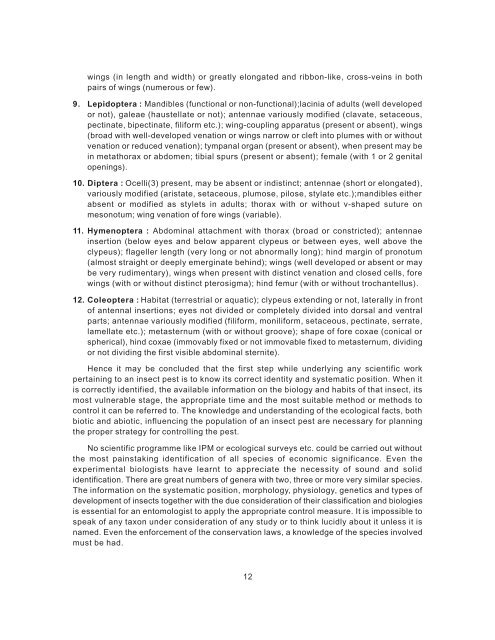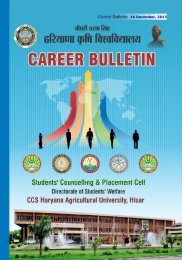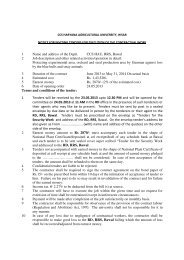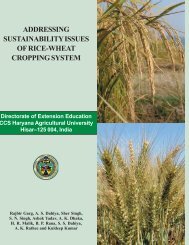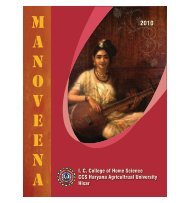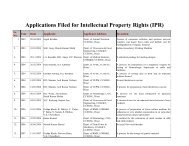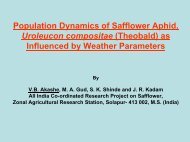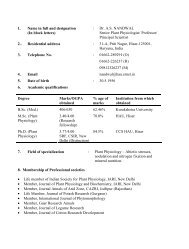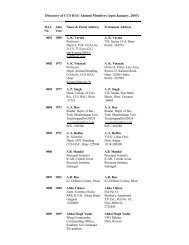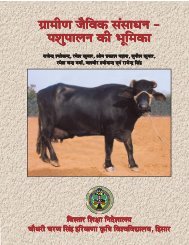Foreword - CCS HAU, Hisar
Foreword - CCS HAU, Hisar
Foreword - CCS HAU, Hisar
You also want an ePaper? Increase the reach of your titles
YUMPU automatically turns print PDFs into web optimized ePapers that Google loves.
wings (in length and width) or greatly elongated and ribbon-like, cross-veins in both<br />
pairs of wings (numerous or few).<br />
9. Lepidoptera : Mandibles (functional or non-functional);lacinia of adults (well developed<br />
or not), galeae (haustellate or not); antennae variously modified (clavate, setaceous,<br />
pectinate, bipectinate, filiform etc.); wing-coupling apparatus (present or absent), wings<br />
(broad with well-developed venation or wings narrow or cleft into plumes with or without<br />
venation or reduced venation); tympanal organ (present or absent), when present may be<br />
in metathorax or abdomen; tibial spurs (present or absent); female (with 1 or 2 genital<br />
openings).<br />
10. Diptera : Ocelli(3) present, may be absent or indistinct; antennae (short or elongated),<br />
variously modified (aristate, setaceous, plumose, pilose, stylate etc.);mandibles either<br />
absent or modified as stylets in adults; thorax with or without v-shaped suture on<br />
mesonotum; wing venation of fore wings (variable).<br />
11. Hymenoptera : Abdominal attachment with thorax (broad or constricted); antennae<br />
insertion (below eyes and below apparent clypeus or between eyes, well above the<br />
clypeus); flageller length (very long or not abnormally long); hind margin of pronotum<br />
(almost straight or deeply emerginate behind); wings (well developed or absent or may<br />
be very rudimentary), wings when present with distinct venation and closed cells, fore<br />
wings (with or without distinct pterosigma); hind femur (with or without trochantellus).<br />
12. Coleoptera : Habitat (terrestrial or aquatic); clypeus extending or not, laterally in front<br />
of antennal insertions; eyes not divided or completely divided into dorsal and ventral<br />
parts; antennae variously modified (filiform, moniliform, setaceous, pectinate, serrate,<br />
lamellate etc.); metasternum (with or without groove); shape of fore coxae (conical or<br />
spherical), hind coxae (immovably fixed or not immovable fixed to metasternum, dividing<br />
or not dividing the first visible abdominal sternite).<br />
Hence it may be concluded that the first step while underlying any scientific work<br />
pertaining to an insect pest is to know its correct identity and systematic position. When it<br />
is correctly identified, the available information on the biology and habits of that insect, its<br />
most vulnerable stage, the appropriate time and the most suitable method or methods to<br />
control it can be referred to. The knowledge and understanding of the ecological facts, both<br />
biotic and abiotic, influencing the population of an insect pest are necessary for planning<br />
the proper strategy for controlling the pest.<br />
No scientific programme like IPM or ecological surveys etc. could be carried out without<br />
the most painstaking identification of all species of economic significance. Even the<br />
experimental biologists have learnt to appreciate the necessity of sound and solid<br />
identification. There are great numbers of genera with two, three or more very similar species.<br />
The information on the systematic position, morphology, physiology, genetics and types of<br />
development of insects together with the due consideration of their classification and biologies<br />
is essential for an entomologist to apply the appropriate control measure. It is impossible to<br />
speak of any taxon under consideration of any study or to think lucidly about it unless it is<br />
named. Even the enforcement of the conservation laws, a knowledge of the species involved<br />
must be had.<br />
12


